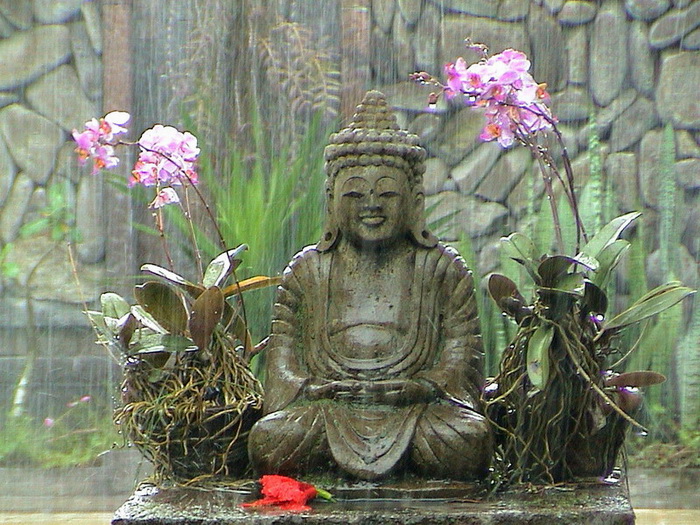Last night we had an unexpected storm. There wasn’t much rain, which California desperately needs, but there was a lot of lightening and thunder. Sitting on the patio, I watched streaks of lightening, many of them horizontal, illuminate the sky to the south and east.
 The next day in the park I saw the drops on the stream before I felt them on my skin. The variable sky had completely occluded just after I sat down at a table downstream from the footbridge. Gently, but insistently, the clouds began to disgorge their moisture.
The next day in the park I saw the drops on the stream before I felt them on my skin. The variable sky had completely occluded just after I sat down at a table downstream from the footbridge. Gently, but insistently, the clouds began to disgorge their moisture.
A steady rain fell for half an hour. It was more than a drizzle but less than a downpour. In addition to my hat and shell, the laurel bay tree overhead provided shelter. Not getting wet, I remained with the impulse to leave until it passed.
Then I saw rain as if for the first time. After ten minutes or so, long after the concern about getting wet or looking foolish had passed, there was an insight that surprised me.
There’s an inherent reverence experiencing a rain. Water is the essence of life, and life, at least new life, is joy. Both qualities were in abundance as the rain fell.
Two women, both with dogs, walked by as the drizzle came down. The first had a friendly, open, pretty face, with eyes that smiled before she said hello. When I said ‘nice rain,’ she exclaimed, “It’s beautiful!”
Meditation descended as softly as the rain. There was just the sight, sound and smell of the present moment. When self-concern and thought drops away, and there is just beauty, joy pours down and overflows within.
I have never understood the concept and practice of group meditation. The term has always sounded like an oxymoron to me. I see little benefit to the individual or society from the practice of sitting silently indoors in groups facing inner and outer walls.
To my mind, awakening a meditative state is an inherently solitary art. As concisely as I can put it, meditation means observing without the separation of the observer, seeing beyond the conditioning of the self, and attentively quieting the mind without focusing or concentrating on anything.
I often hear teachers and students say they don’t like to meditate, but because it does them so much good they keep at it. That seems crazy.
Sittings have always been a joy to me, but then, I don’t sit indoors, and don’t sit surrounded by others in groups. (To my mind group meditation means meditative dialogue, but that’s another column.)
Sometimes I take sittings in the backyard, but the freeway is less than a mile away. Most days I take the time to go for a walk and sitting in the large park that runs through town, or better yet, the semi-wilderness just beyond this small city in northern California.
When I sit in the backyard, I don’t resist the noise of the highway. To me, the noisy mind is like the constant din of a freeway. Resistance and opposition only introduce conflict and more noise.
Sitting with a group of people in a room is like going into a big city to sit in a busy building. I’ve lived in big cities, and actually like many of them, but for meditating, even in a large city, one finds a little park, patio or garden, and sits by oneself.
Are people who try to awaken meditation together seeking comfort and affirmation in the group? And is it like the yoga industry, a way for some to make money?
The traffic that runs through our mind is not merely from our own accumulated and unaddressed experience, but from old family and relationship issues, and more metaphysically, the background din (and deadness in the case of North America) of the culture in which one happens to live.
The brain requires regular periods of wakeful quiet, and a quiet mind requires space and solitude. Sometimes I wonder if I’m missing something about group meditation, but the last time I attended such a session, the facilitator actually said that communal sitting allows him “to feed off the group.” Egad.
Certainly there is merit in taking a few minutes of silence before beginning a dialogue. However for the person who really wants to undergo a radical shift in consciousness that is the hallmark of the meditative state, sitting with a bunch of other busy minds while trying to attend to one’s own mind makes no sense.
Hypothetically, one can meditate anywhere at anytime, even in the midst of people and activity. But practically speaking, one needs to step out of the man-made world, as much as possible, to quiet the mind and bring peace to the heart.
To attain stillness, much less enlightenment, one has to awaken meditation alone.
Martin LeFevre

